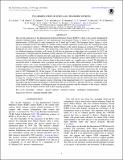IVS OBSERVATION OF ICRF2-GAIA TRANSFER SOURCES
Author(s)
Le Bail, K.; Gipson, J. M.; Gordon, D.; MacMillan, D. S.; Behrend, D.; Thomas, C. C.; Bolotin, S.; Himwich, W. E.; Baver, K. D.; Bourda, G.; Charlot, P.; Collioud, A.; Corey, Brian E.; Titus, Michael A.; ... Show more Show less
DownloadBail-2016-IVS OBSERVATION OF I.pdf (3.264Mb)
PUBLISHER_POLICY
Publisher Policy
Article is made available in accordance with the publisher's policy and may be subject to US copyright law. Please refer to the publisher's site for terms of use.
Terms of use
Metadata
Show full item recordAbstract
The second realization of the International Celestial Reference Frame (ICRF2), which is the current fundamental celestial reference frame adopted by the International Astronomical Union, is based on Very Long Baseline Interferometry (VLBI) data at radio frequencies in X band and S band. The European Space Agency's Gaia mission, launched on 2013 December 19, started routine scientific operations in 2014 July. By scanning the whole sky, it is expected to observe ~500,000 Quasi Stellar Objects in the optical domain an average of 70 times each during the five years of the mission. This means that, in the future, two extragalactic celestial reference frames, at two different frequency domains, will coexist. It will thus be important to align them very accurately. In 2012, the Laboratoire d'Astrophysique de Bordeaux (LAB) selected 195 sources from ICRF2 that will be observed by Gaia and should be suitable for aligning the radio and optical frames: they are called ICRF2-Gaia transfer sources. The LAB submitted a proposal to the International VLBI Service (IVS) to regularly observe these ICRF2-Gaia transfer sources at the same rate as Gaia observes them in the optical realm, e.g., roughly once a month. We describe our successful effort to implement such a program and report on the results. Most observations of the ICRF2-Gaia transfer sources now occur automatically as part of the IVS source monitoring program, while a subset of 37 sources requires special attention. Beginning in 2013, we scheduled 25 VLBI sessions devoted in whole or in part to measuring these 37 sources. Of the 195 sources, all but one have been successfully observed in the 12 months prior to 2015 September 01. Of the sources, 87 met their observing target of 12 successful sessions per year. The position uncertainties of all of the ICRF2-Gaia transfer sources have improved since the start of this observing program. For a subset of 24 sources whose positions were very poorly known, the uncertainty has decreased, on average, by a factor of four. This observing program is successful because the two main goals were reached for most of the 195 ICRF2-Gaia transfer sources: observing at the requested target of 12 successful sessions per year and improving the position uncertainties to better than 200 μas for both R.A. and decl. However, scheduling some of the transfer sources remains a challenge because of network geometry and the weakness of the sources, and this will be one focus of future sessions used in this ongoing program.
Date issued
2016-02Department
Haystack ObservatoryJournal
The Astronomical Journal
Publisher
IOP Publishing
Citation
Le Bail, K., J. M. Gipson, D. Gordon, D. S. MacMillan, D. Behrend, C. C. Thomas, S. Bolotin, et al. “IVS OBSERVATION OF ICRF2-GAIATRANSFER SOURCES.” The Astronomical Journal 151, no. 3 (February 24, 2016): 79. © 2016 The American Astronomical Society
Version: Final published version
ISSN
1538-3881
0004-6256